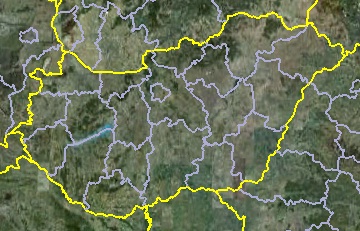|
|
| Territories processed by the modern toponym registry. |

|
|
|
|
The registry contains 258304 toponym data. Contact us Updated: 22 October 2020 |
Chronicle |
2 July 2010
Under the research university tender the Hungarian Digital Toponym Registry programme has been initiated. Two workgroups are involved in the implementation of the programme: the Onomastic Workgroup led by Associate Professor Valéria Tóth (“Modern Hungarian Digital Toponym Registry”) and the History of Language and Toponyms Workgroup led by Professor István Hoffmann (“Research on the History of Hungarian Language and Toponyms”).
The work started when Josef Schwing, Honorary Professor at the University of Mannheim was kind enough to offer us for use the complete digital toponymic corpus of the Baranya, Somogy and Tolna counties of the South-Transdanubia region.
12 July to 6 August 2010
Database-building camp
The aim of the work was to create the foundation for the Hungarian Digital Toponym Registry database which would incorporate the whole modern and historical toponymic corpus.
The one-month work focused on two types of tasks. A group of students worked on building and broadening the South-Transdanubian database, while another group took part in recording the Hajdú-Bihar county toponymic corpus. Parallel to the database-building work a smaller group of students completed the digitisation of the existing settlement maps.
The 23 participants were those students interested in linguistics, who, with their work so far, already justified that they are able to conduct research work. The following students took part in the work: Viktória Barta, Míra Bártfai, Zsanett Béke, Júlia Béres, Gábor Bihary, Hermina Ágnes Gesztelyi, Judit Halmos, Barbara Hunyadi, Csilla Katona, Csilla Kiss, Helga Kovács, Orsolya Magyar, Máté Nagy, Eszter Orosz, Veronika Porczió, Anna Posta, Andrea Seres, Edit Szalmasági, Szilvia Szép, Teodóra Tóth, Dénes Mihály Uri, Ivett Zahorján, Klaudia Zakkar. Our students who became part of the project since then: Hajnalka Dajnoki, Evelin Mozga, Katalin Nagy, Katalin Sváb, Ildikó Vasáros.
PhD students Barbara Bába, Eszter Ditrói, Éva Pásztor and Melinda Szőke also took part in the management of professional work. (See pictures of the work here.) The efforts were largely supported by Josef Schwing, who, accompanied by his IT expert colleague, visited the camp in Debrecen in the first few days and was of help to the ‘campers’ not only as a professional contributor but also delivered a pool of more than 100 computers as a gift to the Institute of Hungarian Linguistics.
(See pictures of the arrival of the computers.)
Thanks to the cooperation of German IT expert Ortwin Zillgen and his Hungarian counterparts Marianna Zichar and Imre Szűcs during the whole period, the underlying database of the software was also developed (4D GIS engine).
We reported about the work in a newspaper article (Hajdú-Bihari Napló, 14 08 2010, read it here), and a radio interview (Friss Rádió, 30 July 2010, listen to it here).
1 to 2 October 2010, Síkfőkút
Hungarian Digital Toponym Registry Workshop
To design the cooperation programme of researchers and students from higher education institutions within and across borders, a two-day conference in the ‘Soó Rezső’ Research House of the University of Debrecen at Síkfőkút was organised to discuss and elaborate on the details of work to be carried out jointly. Our aim was to develop a framework for cooperation in a manner which would support the interests of participating individuals and institutions as well as the implementation of the programme. The following participants attended the conference: János Bárth, Tamás Farkas (Budapest), Gyula Hári (Veszprém), Andrea Bölcskei, Ildikó N. Császi, Lajos Cs. Nagy (Budapest), Attila Hegedűs (Piliscsaba), Zsolt Sebestyén (Nyíregyháza), Tamás Török (Komárom), Magdolna Csomortáni (Kolozsvár), István Nyirkos, István Hoffmann, Valéria Tóth, Katalin Reszegi, Barbara Bába, Melinda Szőke, Éva Kovács, Éva Pásztor, Eszter Ditrói (Debrecen), Gábor Mikesy, Zsolt Pinke, Béla Kocán, Domokos Vékás.
Since December 2010
As from Autumn 2010 students and lecturers from several higher education institutions joined the cooperation programme, and many others indicated their willingness to do so. Before starting work, Barbara Bába, the programme’s coordinator visited the institutions and presented students the workflow of database-building while also making them familiar with the objectives of the programme.
As from December 2010, led by Associate Professor Attila Hegedűs at the ‘Pázmány Péter’ Catholic University’s Department of Hungarian Linguistics, the following students participate in database-building: Péter Ágoston, Diána Dénes, Eszter Farkas, Eszter Hegedűs, Zita Horváth, Orsolya Sári, Teréz Szilveszter, Zsófia Varga, Barbara Vukov. Students from Piliscsaba work on inputting entries into the database of the Győr and Pest toponymic corpus.
As from March 2011, led by Assistant Professor Gyula Hári at the University of Veszprém’s Department of Hungarian Linguistics, the following students participate in the work: Veronika Erdei, Nikolett Kerekes, Rita Kovács, Réka Ligárt, Fruzsina Nébald, Viktória Pályi, Szandra Pápay, Viktória Pintér, Dániel Szabó, Noémi Szabó, Barbara Zakics. Students from Veszprém work on inputting entries into the database of the Veszprém county toponymic corpus.
1 May 2011
The Hungarian Digital Toponym Registry was launched.


